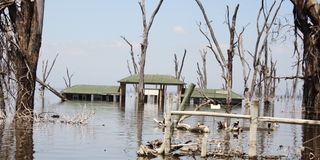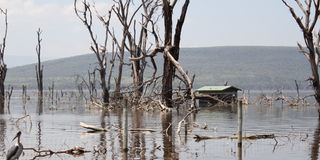Troubled waters: Why Nakuru's flamingo paradise remains under threat

One of the gates to Lake Nakuru National Park that is submerged in water.
When people think of Lake Nakuru National Park, the first thing that comes to mind are the flamingos that paint the lake shore pink and make it a beautiful sight to behold.
These and many other animals have attracted tourists from far and wide, making it one of the must-see places when visiting Nakuru.
However, the rising water levels in the lake have brought many disruptions including damage to vital infrastructure in the park and changes in biodiversity.

Zebras spotted in Lake Nakuru National park.
The Kenya Wildlife Service, who are the direct custodians of this national park, suffered a huge loss in terms of property damage and rehabilitation work.
Speaking to Mtaa Wangu, Mr Titus Mitau, the deputy director in charge of Lake Nakuru National Park, explained that the park's main office, staff houses, perimeter fence and roads are among the infrastructure that were submerged in the lake's waters.
"Due to the damage caused by the rising water levels, we had to relocate our offices. Some of the staff houses were also submerged, but we were able to build some houses for the staff. The roads were badly affected and we had to build new roads to give access to the visitors who come to the park,” Mr Mitau said.
"We have used over Sh70 million to repair roads in the park. We have also used over Sh 30 million to rebuild the staff houses that were destroyed."

Staff houses belonging to KWS officers remain submerged in Lake Nakuru National Park.
According to National Park researcher Joseph Edebe, the flamingos are still in the park.
The only problem is that there is not enough food as the algae they feed on is now scarce due to the change in water chemistry that has reduced the alkalinity of the lake.
For the other animals, Mr Mitau says they were forced to move to other parts of the park that were not affected leaving behind habitats that existed for years.
The national park is also still operating and has not been affected. However, a temporary gate had to be erected to replace the one that was flooded.
On the positive side, tourists who are allowed to visit the park will have the opportunity to explore the lake better because they can travel further than before.
"Reconstructing the roads and houses cost the Kenya Wildlife Service over Sh100 million. As far as the fences are concerned, reconstruction is not yet complete as some parts are still under water. We cannot risk connecting electricity to these poles," says Mr Mitau.
The damage to the park is visible from the main gate next to Summit resort, where you can easily see the drying trees that have been soaked by the lake water, giving the park an ugly look.
